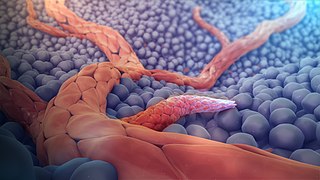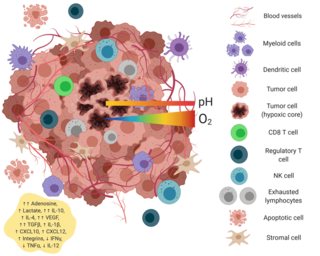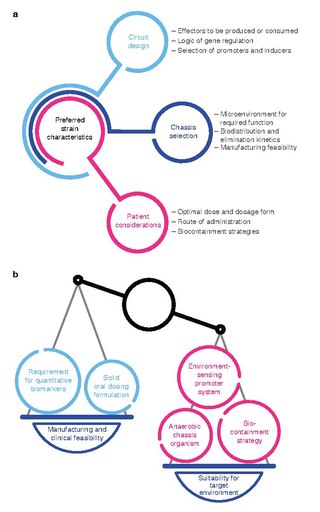Related Research Articles

Angiogenesis is the physiological process through which new blood vessels form from pre-existing vessels, formed in the earlier stage of vasculogenesis. Angiogenesis continues the growth of the vasculature mainly by processes of sprouting and splitting, but processes such as coalescent angiogenesis, vessel elongation and vessel cooption also play a role. Vasculogenesis is the embryonic formation of endothelial cells from mesoderm cell precursors, and from neovascularization, although discussions are not always precise. The first vessels in the developing embryo form through vasculogenesis, after which angiogenesis is responsible for most, if not all, blood vessel growth during development and in disease.

Glioblastoma, previously known as glioblastoma multiforme (GBM), is the most aggressive and most common type of cancer that originates in the brain, and has a very poor prognosis for survival. Initial signs and symptoms of glioblastoma are nonspecific. They may include headaches, personality changes, nausea, and symptoms similar to those of a stroke. Symptoms often worsen rapidly and may progress to unconsciousness.
An angiogenesis inhibitor is a substance that inhibits the growth of new blood vessels (angiogenesis). Some angiogenesis inhibitors are endogenous and a normal part of the body's control and others are obtained exogenously through pharmaceutical drugs or diet.
Intravasation is the invasion of cancer cells through the basement membrane into a blood or lymphatic vessel. Intravasation is one of several carcinogenic events that initiate the escape of cancerous cells from their primary sites. Other mechanisms include invasion through basement membranes, extravasation, and colonization of distant metastatic sites. Cancer cell chemotaxis also relies on this migratory behavior to arrive at a secondary destination designated for cancer cell colonization.

Steven Kenneth Libutti, M.D., F.A.C.S. is an American surgeon and scientist. In January 2017, he became the third permanent Director of the Rutgers Cancer Institute of New Jersey, Vice Chancellor for Cancer Programs for Rutgers Biomedical and Health Sciences and the Senior Vice President for Oncology Services for RWJBarnabas Health, the largest health system in New Jersey. He is a tenured Distinguished Professor of Surgery at the Rutgers Robert Wood Johnson Medical School. Libutti's work on the study of tumor angiogenesis and the tumor microenvironment has led to novel approaches for the treatment of cancer. He is also one of the pioneers of regional and targeted cancer therapy.
Tumor-associated macrophages (TAMs) are a class of immune cells present in high numbers in the microenvironment of solid tumors. They are heavily involved in cancer-related inflammation. Macrophages are known to originate from bone marrow-derived blood monocytes or yolk sac progenitors, but the exact origin of TAMs in human tumors remains to be elucidated. The composition of monocyte-derived macrophages and tissue-resident macrophages in the tumor microenvironment depends on the tumor type, stage, size, and location, thus it has been proposed that TAM identity and heterogeneity is the outcome of interactions between tumor-derived, tissue-specific, and developmental signals.
Dr. Cora Sternberg is an American medical oncologist at Weill Cornell Medicine and NewYork-Presbyterian Hospital, serving as a member of the Genitourinary (GU) Oncology Program. Dr. Sternberg facilitates the continued growth and development of clinical and translational research programs in GU malignancies. Dr. Sternberg is an internationally respected leader in the field of medical oncology and urological malignancies and a recognized expert in the area of new drug development. She is known for her seminal contributions in bladder cancer, her strong track record of sustained genito-urinary (GU) oncology leadership and collaboration in multiple practice-changing clinical trials, including novel medicines, and her current role applying her expertise in oncology and GU cancers to precision medicine to further improve outcomes for patients. Dr. Sternberg has been decidedly influential in the development of novel hormonal therapies and checkpoint inhibitors across the landscape of GU oncology as evidenced in her curriculum vitae. She is a globally respected researcher who has lectured extensively at universities and cancer symposia worldwide (>800). As Clinical Director of the Englander Institute for Precision Medicine (EIPM), Dr. Sternberg develops strategies to incorporate genomic sequencing and precision medicine throughout the Weill Cornell Medicine and NewYork-Presbyterian healthcare network, including Lower Manhattan, Brooklyn and Queens.

The tumor microenvironment is a complex ecosystem surrounding a tumor, composed of cancer cells, stromal tissue and the extracellular matrix. Mutual interaction between cancer cells and the different components of the tumor microenvironment support its growth and invasion in healthy tissues which correlates with tumor resistance to current treatments and poor prognosis. The tumor microenvironment is in constant change because of the tumor's ability to influence the microenvironment by releasing extracellular signals, promoting tumor angiogenesis and inducing peripheral immune tolerance, while the immune cells in the microenvironment can affect the growth and evolution of cancerous cells.
The stresses, one of the physical hallmarks of cancer, is exerted by the solid components of a tissue and accumulated within solid structural components during growth and progression.

Vasculogenic mimicry (VM) is a strategy used by tumors to ensure sufficient blood supply is brought to its cells through establishing new tumor vascularization. This process is similar to tumor angiogenesis; on the other hand vascular mimicry is unique in that this process occurs independent of endothelial cells. Vasculature is instead developed de novo by cancer cells, which under stress conditions such as hypoxia, express similar properties to stem cells, capable of differentiating to mimic the function of endothelial cells and form vasculature-like structures. The ability of tumors to develop and harness nearby vasculature is considered one of the hallmarks of cancer disease development and is thought to be closely linked to tumor invasion and metastasis. Vascular mimicry has been observed predominantly in aggressive and metastatic cancers and has been associated with negative tumor characteristics such as increased metastasis, increased tissue invasion, and overall poor outcomes for patient survival. Vascular mimicry poses a serious problem for current therapeutic strategies due to its ability to function in the presence of Anti-angiogenic therapeutic agents. In fact, such therapeutics have been found to actually drive VM formation in tumors, causing more aggressive and difficult to treat tumors to develop.
William Mark Saltzman was named the Goizueta Foundation Professor of Biomedical and Chemical Engineering at Yale University on July 1, 2002 and became the founding chair of Yale's Department of Biomedical Engineering in 2003. Saltzman's research aims to promote new methods for drug delivery and develop new biotechnologies to combat human disease. A pioneer in the fields of biomaterials, nanobiotechnology, and tissue engineering, Saltzman has contributed to the design and implementation of a number of clinical technologies that have become essential to medical practice today. His popular course Frontiers of Biomedical Engineering is available to everyone through Open Yale Courses.

Holger Lode is a German specialist for pediatrics. He is Professor and Chair of the Department of General Pediatrics and Pediatric Hematology and Oncology at the University Medicine Greifswald. He is also the director of the Center of Pediatrics and Adolescent Medicine in Greifswald. Lode is well known for his clinical and scientific work on immunotherapy of neuroblastoma.

J. William Harbour is an American ophthalmologist, ocular oncologist and cancer researcher. He is Chair of the Department of Ophthalmology at the University of Texas Southwestern Medical Center in Dallas. He previously served as the vice chair and director of ocular oncology at the Bascom Palmer Eye Institute and associate director for basic science at the Sylvester Comprehensive Cancer Center of the University of Miami's Miller School of Medicine.

Tumor-associated endothelial cells or tumor endothelial cells (TECs) refers to cells lining the tumor-associated blood vessels that control the passage of nutrients into surrounding tumor tissue. Across different cancer types, tumor-associated blood vessels have been discovered to differ significantly from normal blood vessels in morphology, gene expression, and functionality in ways that promote cancer progression. There has been notable interest in developing cancer therapeutics that capitalize on these abnormalities of the tumor-associated endothelium to destroy tumors.
Yun Chae-ok (Korean: 윤채옥) is a Korean-born scientist and professor of Bioengineering at Hanyang University, Seoul, Korea.
Jason S. Lewis is a British radiochemist whose work relates to oncologic therapy and diagnosis. His research focus is a molecular imaging-based program focused on radiopharmaceutical development as well as the study of multimodality small- and biomolecule-based agents and their clinical translation. He has worked on the development of small molecules as well as radiolabeled peptides and antibodies probing the overexpression of receptors and antigens on tumors.

Bacterial therapy is the therapeutic use of bacteria to treat diseases. Bacterial therapeutics are living medicines, and may be wild type bacteria or bacteria that have been genetically engineered to possess therapeutic properties that is injected into a patient. Other examples of living medicines include cellular therapeutics, activators of anti-tumor immunity, or synergizing with existing tools and approaches. and phage therapeutics, or as delivery vehicles for treatment, diagnosis, or imaging, complementing or synergizing with existing tools and approaches.

Debra Auguste is an American chemical engineer and professor at Northeastern University in the department of chemical engineering. Auguste is dedicated to developing treatments for triple negative breast cancer, one of the most aggressive and fatal cancers that disproportionately affects African American women. Her lab characterizes biomarkers of triple negative breast cancer and develops novel biocompatible therapeutic technologies to target and destroy metastatic cancer cells. Auguste received the 2012 Presidential Early Career Award for Scientists and Engineers and in 2010 was named in the 50 Most Influential African-Americans in Technology. In 2020, Auguste became an Elected Fellow of the American Institute for Medical and Biological Engineering.
Priyabrata Mukherjee is an American, academic researcher and professor. He is a Presbyterian Health Foundation presidential professor at the University of Oklahoma Health Sciences Center and associate director for translational research at Stephenson Cancer Center at the OU Health Sciences Center. He also holds the Peggy and Charles Stephenson endowed chair in cancer laboratory research at the OU Health Sciences Center.
Bushra Ateeq is a Professor and a Senior Fellow of the DBT/Wellcome Trust India Alliance in the Department of Biological Sciences and Bioengineering (BSBE), IIT Kanpur specializing in cancer biology and molecular oncology. She was awarded the Shanti Swarup Bhatnagar Prize for Science and Technology in Medical Sciences in the year 2020. Her research interest involves exploration of the genetic and epigenetic changes that initiate cancer and its progression. She is also focusing on understanding the molecular events that drive cancer and resistance towards chemotherapeutic drugs.
References
- ↑ Steele Laboratories web site
- ↑ Thomson-Reuters list of highly cited researchers
- 1 2 ASCO Post, August 15, 2014; Vol. 5, Issue 13
- ↑ National Science & Technology Medals Foundation
- ↑ Jain, RK. Barriers to drug delivery in solid tumors. Sci Am, 271: 58-65, 1994
- ↑ Jain, RK. Taming vessels to treat cancer. Sci Am, 298: 56-63, 2008
- ↑ Jain, RK. An indirect way to tame cancer. Sci Am, 310: 46-53, 2014
- ↑ Jain, RK and PF Carmeliet. Vessels of death or life. Sci Am, 285: 38-45, 2001
- ↑ Jain, RK. Normalizing tumor microenvironment to treat cancer: bench to bedside to biomarkers. J Clin Oncol, 31: 2205-18, 2013
- ↑ Video of the award lecture, Normalizing Tumor Microenvironment to Treat Cancer: Bench to Bedside to Biomarkers; 2012 ASCO Annual Meeting
- ↑ Jain, RK. Antiangiogenesis strategies revisited: from starving tumors to alleviating hypoxia. Cancer Cell, 26: 605-22, 2014
- ↑ Jain, RK. Normalizing tumor vasculature with anti-angiogenic therapy: a new paradigm for combination therapy. Nat Med, 7: 987-9, 2001
- ↑ Jain, RK. Normalization of tumor vasculature: an emerging concept in antiangiogenic therapy. Science, 307: 58-62, 2005